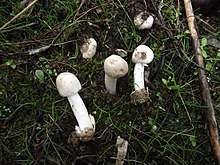Torrendia
Torrendia is a genus of agaric fungi in the family Amanitaceae[1] in part defined by being sequestrate. By molecular analyses the genus was shown to be part of Amanita[2] and has now been placed in synonymy with Amanita.[3] The type species, Torrendia pulchella, was first described by Italian mycologist Giacomo Bresadola in 1902, based on material collected in Portugal and sent to him by Camille Torrend.[4] It has been renamed in Amanita as Amanita torrendii.[3]
| Torrendia | |
|---|---|
 | |
| Torrendia pulchella (= Amanita torrendii) | |
| Scientific classification | |
| Kingdom: | |
| Division: | |
| Class: | |
| Order: | |
| Family: | |
| Genus: | Torrendia |
| Type species | |
| Torrendia pulchella Bres. (1902) | |
| Species | |
| |
Species
- Torrendia arenaria
- Torrendia deformans
- Torrendia grandis
- Torrendia inculta
- Torrendia pulchella
gollark: I do not, in general, think that being obligated to "respect" people's beliefs because they're, well, strongly hold beliefs, is very good.
gollark: Ah.
gollark: "Don't be an idiot"?
gollark: Yes. Liquid crystal displays.
gollark: Thanks for keeping count*!
References
- Miller OK Jr, Horak E (1992). "Observations on the genus Torrendia and a new species from Australia". Mycologia. 84 (1): 64–71. doi:10.2307/3760402. JSTOR 3760402.
- Moncalvo JM, Vilgalys R, Redhead SA, Johnson JE, James TY, Catherine Aime M, Hofstetter V, Verduin SJ, Larsson E, Baroni TJ, Greg Thorn R, Jacobsson S, Clémençon H, Miller OK (2002). "One hundred and seventeen clades of euagarics" (PDF). Molecular Phylogenetics and Evolution. 23 (3): 357–400. doi:10.1016/S1055-7903(02)00027-1. PMID 12099793.
- Justo A, Morgenstern I, Hallen-Adams HE, Hibbett DS (2010). "Convergent evolution of sequestrate forms in Amanita under Mediterranean climate conditions". Mycologia. 102 (3): 675–688. doi:10.3852/09-191. PMID 20524599.
- Bresadola J. (1902). "Mycetes lusitanici novi". I.R. Accad. Sc. Lett. E Arti degli Agiatti in Roverto, Series 3. 8: 127–33.
This article is issued from Wikipedia. The text is licensed under Creative Commons - Attribution - Sharealike. Additional terms may apply for the media files.